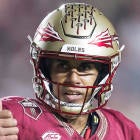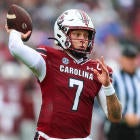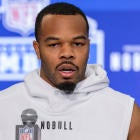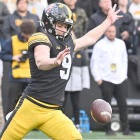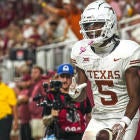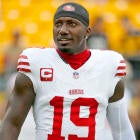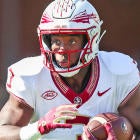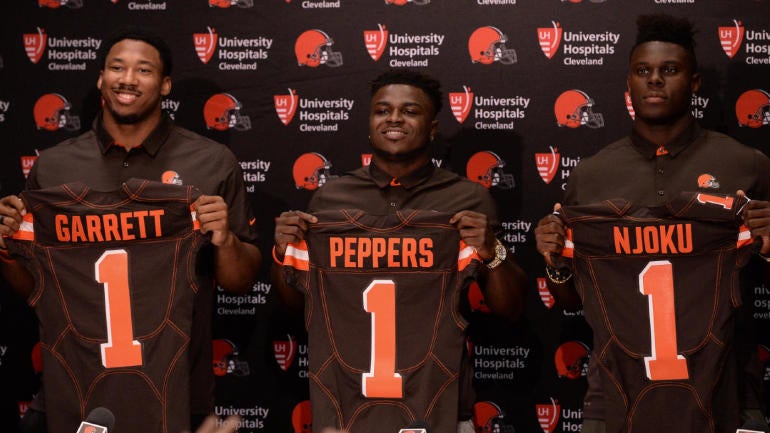
The Philadelphia Eagles find themselves in a unique position in the 2022 NFL Draft, having three first-round picks at their disposal. Philadelphia has a unique setup of first-round picks, all right around each other at No. 15, No. 16, and No. 19. Whether the Eagles use these draft picks are another story, considering general manager Howie Roseman likes to wheel and deal in the first round (the Eagles have traded their original first-round pick in four of the past six years).
Having three first-round picks is unusual, but it isn't an unseen occurrence. Since the 1970 AFL-NFL merger, 15 teams have made three picks in the first round of the same draft -- a trend that has grown in recent years with many front offices wishing to stockpile assets in order to build a championship roster. Have those moves worked? What players did these teams with three first-round picks in the same draft select?
Let's take a look back at all the teams that made three first-round picks in the same draft since the merger -- and how they fared.
2019 -- New York Giants
Draft picks
- No. 6: Daniel Jones, QB, Duke
- No. 17: Dexter Lawrence, DT, Clemson
- No. 30: Deandre Baker, CB, Georgia
The Giants had never before had three first-round picks in their history, and had an opportunity to make a huge splash in 2019 with the draft haul former general manager Dave Gettleman acquired. They took Jones as the second quarterback off the board in what turned out to be a weak quarterback class outside of Kyler Murray.
Jones has been the second-best quarterback in the 2019 draft (which isn't saying much), throwing for 21 touchdowns to 17 interceptions over the last two years. His career passer rating is 84.3 and has 36 fumbles in 38 career games. Pro Bowlers Josh Allen (the defensive end) and T.J. Hockenson were taken right after Jones.
Lawrence has started 41 of 48 career games, but Pro Bowl defensive tackle Jeffery Simmons was taken two picks after him. New York traded three picks to move up in the draft to select Baker, who was released from the team a year later following an arrest in May 2020 (the charges were later dropped). Baker spent the last two seasons with the Kansas City Chiefs.
The Giants have a 14-35 record since those picks, failing to find an impact player with any one of them.
Grade: D
2019 -- Oakland Raiders
Draft picks
- No. 4: Clelin Ferrell, DE, Clemson
- No. 24: Josh Jacobs, RB, Alabama
- No. 27: Johnathan Abram, S, Mississippi State
Jon Gruden had an opportunity to transform the Raiders franchise with these three picks. Instead Oakland had mixed results in the year before the Raiders moved to Las Vegas.
Farrell was a controversial pick at No. 4, having just eight sacks in three years (he didn't start a game in 2021). Maxx Crosby, another pass rusher taken in the fourth round, has 25 sacks in three years and was a second team All-Pro in 2021. Gruden selected the difference-making edge rusher later in that draft.
Jacobs has two 1,000-yard seasons and has rushed for 28 touchdowns in three years, becoming a vital part of the Raiders' run game.
Abram has started 27 games over the last two years after missing the majority of his rookie season due to injury, recording three interceptions and 202 tackles -- including 116 this past season.
This haul would look much better if Farrell wasn't a disappointment.
Grade: C
2017 -- Cleveland Browns
Draft picks
- No. 1: Myles Garrett, DE, Texas A&M
- No. 25: Jabrill Peppers, S, Michigan
- No. 29: David Njoku, TE, Miami
Hard to find a more impactful No. 1 pick on the defensive side of the ball over the last 30 years than Garrett, who has lived up to the hype. Garrett has 58.5 sacks in 68 games, totaling double-digit sack totals in each of the last four years. A three-time Pro Bowler and two-time All-Pro, Garrett is one of the best pass rushers in football.
Peppers was traded to the New York Giants after two years in Cleveland (137 tackles, one sack, no forced fumbles) as the Browns received Odell Beckham Jr. in return. Njoku has 1,754 yards and 11 touchdowns in five seasons with the Browns, but the pick right after him was T.J. Watt.
Garrett's dominance makes this first-round class earn a much higher grade, but crazy to think Cleveland could have had Garrett and Watt.
Grade: B-
2013 -- Minnesota Vikings
Draft picks
- No. 23: Sharrif Floyd, DT, Florida
- No. 25: Xavier Rhodes, CB, Florida State
- No. 29: Cordarrelle Patterson, WR, Tennessee
For having three picks in the 20s, the Vikings could have done much worse. Floyd was out of the league by 24 due to health problems, starting 24 of 44 games and recording 9.5 sacks in four seasons.
Rhodes had the biggest impact for Minnesota, earning three Pro Bowls and an All-Pro nod in seven seasons with the team. He finished fourth in Defensive Player of the Year voting in 2017, having two interceptions and allowing a 73.2 passer rating in coverage.
Patterson was a two-time All-Pro returner in his four seasons with the Vikings, having five kick-return touchdowns and leading the NFL in yards per return three times (the years which he played a full season). He parlayed that success into a spot on the All-Decade Team, even though he didn't live up to the first-round status as a wide receiver. He had 132 catches and 1,316 yards and seven touchdowns in Minnesota, yet has found a home in Atlanta (career-high 1,166 scrimmage yards in 2021).
A solid haul for Minnesota given all things considered.
Grade: B-
2001 -- St. Louis Rams
Draft picks
- No. 12: Damione Lewis, DT, Miami
- No. 20: Adam Archuleta, S, Arizona State
- No. 29: Ryan Pickett, DT, Ohio State
The Rams were coming off consecutive playoff appearances, which included a Super Bowl championship in 1999. This was an opportunity to build a dynasty. Instead, Rams general manager Charley Armey and head coach Mike Martz dropped the ball.
Lewis never started more than 10 games in a season in five years with the Rams, totaling 10.5 sacks and two forced fumbles. Pickett, who was picked 17 spots after Lewis, started 59 of his final 64 games with the Rams and ended up lasting 14 years in the league (Lewis played 10 years). Not many impact players were taken immediately after Lewis, although Hall of Famer Steve Hutchinson was selected at No. 16. Reggie Wayne and Todd Heap were taken right after Pickett.
Archuleta's best years were with the Rams, becoming an impact player on a defense that helped St. Louis win the NFC Championship in 2001. He finished with 15 sacks and 22 passes defensed in five years with St. Louis before signing a massive free agent deal with Washington.
This draft class could have been significantly better -- and the Rams might have earned another title.
Grade: C
2000 -- New York Jets
Draft picks
- No. 12: Shaun Ellis, DE, Tennessee
- No. 13: John Abraham, DE, South Carolina
- No. 18: Chad Pennington, QB, Marshall
- No. 27: Anthony Becht, TE, USC
The 2000 Jets are the only team in NFL history to make four first-round picks in the same draft. Two came from the Tampa Bay Buccaneers thanks to the Keyshawn Johnson trade and the other pick was from the trade that sent Bill Belichick to the New England Patriots.
Ellis earned two Pro Bowl berths and had two double-digit sack seasons in his 10 seasons with the Jets, finishing with 72.5 sacks with the team. Abraham was the first pick the Jets used from the Buccaneers trade, earning three Pro Bowls and an All-Pro selection in his six seasons in New York (53.5 sacks and led the league with six forced fumbles in 2001). Abraham played 15 seasons and earned five Pro Bowl selections with eight double-digit sack campaigns. He's 13th all time in sacks (133.5) and third all time in forced fumbles (47).
Pennington led the Jets to the playoffs three times and led the league in completion percentage (68.9) and passer rating (104.2) in his first season as the starting quarterback for the team (2002). He threw for 13,738 yards, 82 touchdowns and 55 interceptions in eight years with the team, winning Comeback Player of the Year in 2006.
Becht finished with 1,164 yards and 17 touchdowns in five seasons with the Jets. New York had a slam-dunk pick with Abraham and hit on Ellis and Pennington. They also got a starter in Becht. Not a bad haul of first-round picks for a franchise that doesn't have an excellent recent history of drafting in the opening round.
Grade: A-
1995 -- Carolina Panthers
Draft picks
- No. 5: Kerry Collins, QB, Penn State
- No. 22: Tyrone Poole, CB, Fort Valley State
- No. 29: Blake Brockermeyer, T, Texas
The Panthers didn't get rewarded for the fruits of their labor with any of these picks, all made in their first season as a franchise. Carolina traded down from the No. 1 pick to No. 5 and took Collins. who made the Pro Bowl with the Panthers in 1996 before alcohol issues led to his release early in the 1998 season. Collins completed just 51.8% of his passes for 8,306 yards with 47 touchdowns to 54 interceptions (66.0 rating) during his career with the Panthers, before leading the New York Giants to Super Bowl XXXV in 2000 and throwing for 40,922 yards in his career.
Poole played three seasons in Carolina before being traded to the Indianapolis Colts in 1998. He won two Super Bowls with the New England Patriots and played 12 seasons, only having five interceptions and 188 tackles in Carolina.
Brockermeyer played four seasons with the Panthers and started 55 of 58 games at left tackle before starting 45 of 46 games with the Chicago Bears. The Panthers picked solid players that had long careers, but their best years weren't in Carolina.
Grade: D+
1991 -- Dallas Cowboys
Draft picks
- No. 1: Russell Maryland, DT, Miami
- No. 12: Alvin Harper, WR, Tennessee
- No. 20: Kelvin Pritchett, DT, Mississippi
The Cowboys found two key components for their three Super Bowl teams in Maryland and Harper. Dallas made a deal with the New England Patriots prior to the draft to get the No. 1 overall pick and select Maryland, who had 14.5 sacks and seven forced fumbles in five seasons with the Cowboys -- earning a Pro Bowl berth in 1993. Maryland started 54 of 59 games during the Cowboys' dynasty years from 1992 to 1995 before departing in free agency.
Harper was the big-play threat in the Cowboys' offense from 1991 to 1994, averaging 20.0 yards per catch opposite to Michael Irvin. His best years were easily with Dallas, having 124 catches for 2,486 yards and 18 touchdowns (led the league with 24.9 yards per catch in 1994). He finished with 24 catches for 655 yards and four touchdowns in the playoffs, averaging an incredible 27.3 yards per catch and winning two Super Bowls with Dallas (averaged over 40 yards per catch in the playoffs twice).
Dallas traded Pritchett to the Detroit Lions after he was selected, but Pritchett lasted 14 years in the NFL and finished with 31.5 sacks. The Maryland and Harper picks were key players in Dallas winning Super Bowl titles and forming a dynasty, making this draft haul great.
Grade: A-
1988 -- Los Angeles Raiders
Draft picks
- No. 6: Tim Brown, WR, Notre Dame
- No. 9: Terry McDaniel, CB, Tennessee
- No. 25: Scott Davis, DT, Illinois
The Raiders struck gold on their top-10 picks in this draft with Brown and McDaniel. Brown wasn't a great wide receiver immediately, but his outstanding kick-returning skills made him one of the league's top big-play threats (and two Pro Bowl berths). He earned nine Pro Bowls in 16 seasons with the Raiders and made the All-Decade Team, finishing his Raiders career with 1,070 catches for 14,734 yards and 99 receiving touchdowns (104 all-purpose touchdowns). Brown's 19,682 all-purpose yards, 1,094 career receptions, and 14,934 receiving yards are seventh in NFL history -- earning a spot in the Hall of Fame.
McDaniel made five Pro Bowls and two second team All-Pro selections with the Raiders, notching 34 interceptions in 10 seasons with the team. He had 27 interceptions from 1992 through 1996, making five straight Pro Bowls. Davis had 27.5 sacks in five seasons with the Raiders, earning a double-digit sack season in 1990. He retired in 1991 only to return in 1994 before suffering a career-ending injury.
The Raiders hit on all three of these draft picks, an incredible amount of talent that carried the franchise in their final years in Los Angeles.
Grade: A+
1984 -- Cincinnati Bengals
Draft picks
- No. 7: Ricky Hunley, LB, Arizona
- No. 16: Pete Koch, NT, Maryland
- No. 28: Brian Blados, T, North Carolina
The Bengals' draft haul from 1984 didn't have any players that actually performed for their team. Hunley never played a down for the Bengals, who traded him to the Denver Broncos in exchange for first- and third-round picks in 1986. Koch played just one season in Cincinnati before he was out, more known for his acting career than his football career.
Blados played on the Bengals for eight seasons, starting at left guard and right tackle on the offensive line. He started 60 of 98 games with Cincinnati, the latter years as a backup.
Cincinnati got wide receiver Tim McGee and All-Pro safety David Fulcher with those 1986 picks, more than making up for Hunley not wanting to play there. The 1984 first-round draft haul still wasn't anything to brag about.
Grade: D
1983 -- San Diego Chargers
Draft picks
- No. 5: Billy Ray Smith, LB, Arkansas
- No. 20: Gary Anderson, RB, USC
- No. 22: Gill Byrd, CB, San Diego State
The Chargers selected longtime starters with their three picks, as Smith played 10 seasons with the team and finished with 26.5 sacks. Smith even had 11 sacks in the 1986 season, but didn't make the Pro Bowl.
Anderson played two years in the USFL before arriving in San Diego, making the Pro Bowl in 1986 with 1,313 scrimmage yards (871 receiving yards and eight touchdowns). He rushed for 1,119 yards in 1988 before holding out the 1989 season due to a contract dispute. Anderson finished with 4,228 scrimmage yards and 23 touchdowns in four seasons with the Chargers.
Byrd was the best of the bunch, earning a franchise record 42 interceptions in 10 seasons with the team. He earned two Pro Bowls and a second team All-Pro selection in his final year. The Chargers did pretty well with their draft capital.
Grade: B+
1977 -- Cincinnati Bengals
Draft picks
- No. 3: Eddie Edwards, DE, Miami
- No. 8: Wilson Whitley, DT, Houston
- No. 22: Mike Cobb, TE, Michigan State
The Bengals took the 1977 draft to improve a defensive line that played a major role toward their 1981 AFC Championship. Getting the No. 3 pick by sending Sherman White to the Buffalo Bills, Edwards finished with 84.5 sacks in 12 seasons with three double-digit sack campaigns.
Cincinnati got the No. 8 pick by sending Bill Bergey to the Philadelphia Eagles and selecting Whitley, who started 79 of 82 games in his six seasons with the team. Cobb played just one year with the Bengals, never recording a catch with the team.
Edwards and Whitley made this draft haul above average, as the Bengals transformed from one of the worst teams in the league to the Super Bowl in just three years.
Grade: B-
1976 -- New England Patriots
Draft picks
- No. 5: Mike Haynes, CB, Arizona State
- No. 12: Pete Brock, C, Colorado
- No. 21: Tim Fox, S, Ohio State
The Patriots scored on two stud defensive backs in this draft, making this first-round draft haul all the more impressive. Haynes is one of the best draft picks in franchise history, earning six second team All-Pro selections in seven seasons with the Patriots. He had six Pro Bowl sections and recorded 28 interceptions. The 1976 Defensive Rookie of the Year, Haynes had eight interceptions in his first season and finished his Hall of Fame career with 46 interceptions, nine Pro Bowls, and two All-Pro selections in 14 seasons with the Patriots and Los Angeles Raiders.
Fox had 17 interceptions in six seasons in New England, earning a Pro Bowl berth in 1980. He played 11 seasons in the NFL, earning a second team All-Pro selection in 1982 with the San Diego Chargers. Brock played 12 seasons with the Patriots, starting 88 of 154 games at left tackle and center -- finding a permanent spot in the middle of the line in 1981.
Haynes and Fox make this first-round draft class special for New England, especially since Haynes ended up in the Hall of Fame.
Grade: A
1975 -- Los Angeles Rams
Draft picks
- No. 9: Mike Fanning, DT, Notre Dame
- No. 11: Dennis Harrah, G, Miami
- No. 20: Doug France, T, Ohio State
The Rams found key contributors toward their run of seven straight division titles in the 1970s, culminating with a Super Bowl XIV appearance in the 1979 season. Fanning had 35.5 sacks in eight seasons with the Rams, including 10 sacks in 1980. He rotated as a reserve and starter.
Harrah was one of the best guards in the league for a decade, earning six Pro Bowls in 13 years and an All-Pro selection at age 33 (1986). France was a stalwart left tackle for the Rams in the 1970s, earning two Pro Bowls and a second team All-Pro selection.
The Rams hit big on the offensive line in this draft, which is why they were able to have a dominant NFC West run in the 1970s.
Grade: A
1973 -- New England Patriots
Draft picks
- No. 4: John Hannah, G, Alabama
- No. 11: Sam Cunningham, RB, USC
- No. 19: Darryl Stingley, WR, Purdue
The Patriots struck gold in this draft, selecting the greatest player in franchise history before Tom Brady showed up. Hannah was the best left guard in the league for 13 seasons, starting all 183 games he played and earning seven All-Pro selections and nine Pro Bowl appearances. Hannah made two All-Decade Teams and was selected to the Hall of Fame.
Cunningham was instrumental in one of the greatest turnarounds in Patriots history in 1976, rushing for 824 yards (4.8 yards per carry) as New England went from a 3-11 record in 1975 to 11-3 in 1976 and a second-place finish in the AFC East. Cunningham rushed for 1,015 yards in 1977 and made his lone Pro Bowl in 1978. The Patriots set a then-NFL rushing record for yards in a season (3,165) in 1978 before the Baltimore Ravens broke the mark in 2019 -- thanks to the contributions of Cunningham.
Stingley played five years with the Patriots and caught 110 passes for 1,883 yards and 14 touchdowns (17.1 yards per catch). The Patriots got a Hall of Famer and a longtime running back out of this draft, certainly not a bad haul with premium picks.
Grade: A+















